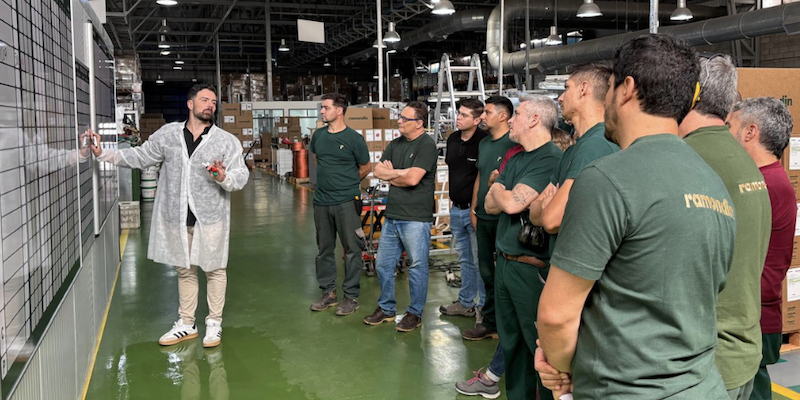
Why is it so hard to do lean without a sensei?
FEATURE – Why do lean transformations benefit from the support of a sensei? Michael Ballé discusses how we typically need help to take the emotions out of the work and go down uncomfortable paths.
Words: Michael Ballé, lean author, executive coach and co-founder of Institut Lean France
Sensei: “What’s your next strategic move?”
Executive: “We want to attract new customers by adding a new product to our range.”
Sensei: “And how are you going to do that?”
Executive: “We can’t afford the risk of a new facility, so we will introduce the new product in the existing plant.”
Sensei: “So, you need more flexibility?”
Executive: “Yes, that’s right.”
Sensei: “Are you working on SMED?”
Executive: “We have run some experiments.”
Sensei: “Have you evaluated how much capacity you need to create for the new product?”
Executive: “Ehm…”
Sensei: “And do you have a target of what batch size reduction this requires?”
Executive: “Well…”
Sensei: “And so you have a plan of how many SMED activities you must run across the plant to achieve this batch size reduction before the new product hits the production floor?”
Executive: “…”
If you practice lean, you have likely had conversations like this. What is going on in these situations? What does the sensei bring to the party? Can’t the executive think for herself? Why does she go quiet?
When cooking bacon and eggs, the chicken is involved, but the pig is committed. To understand how people react, we need to look at where they have skin in the game. The sensei’s commitment is to the logic – and then to the gemba, the practice – of lean. The executive’s commitment is to getting things done.
The sensei is following the (lean) logic of the argument: capacity needed for a new product --> more changeovers without losing capacity --> SMED kaizen exercises with the teams to learn to realize changeovers safely, with good quality (last good part, first good part) and much more quickly. It’s a clear-cut learning curve.
The executive doesn’t disagree, but her brain is being flooded with cortisol – the stress hormone. She sees all the guys she needs to convince, all the workshop she needs to organize, all the time and expense this is going to take and the horrid risk of failure due to the usual resistance to change, all the fights with her middle managers. Her brain is cooking in stress and her body just wants to fight or flight – either get the sensei to say something else or run away.
But the executive is not stupid – if the sensei’s logic is clear enough, her neocortex will reassert itself, and she will start thinking about how to get from here to there.
Left to herself, however, the executive will find it very hard to think this through. As she plans her route to success, stress will make her disregard all the scariest ideas, those she feels won’t be possible to realize right away. Brilliant strategic thinkers are those who don’t shy away from difficulty and end up deciding that the safest place to land in France on D-Day, for instance, is on beaches with huge cliffs defended by machine guns. Crazy on the face of it, but brilliant as a strategic move – if we crack this upfront, the road beyond is a home run.
Thinking against oneself, as Jacques Chaize (one of my co-authors) puts it, is hard and an acquired skill requiring practice. This is where sensei help. They don’t need to be brilliant coaches, supernatural thinkers, or blazingly insightful. They need to know their stuff and get you to face the logic of “how” you’re going to achieve your “why.”
Without a sensei, the executive will naturally come up with a vague “Hail Mary” plan that stresses the intent but shies away from the hard waypoints, relying instead on high-level concepts and general ideas without actually setting concrete priorities and activities. And the same will happen at the plan implementation phase.
Sensei: “How much time have you saved on the changeover?”
Executive: “About 20%.”
Sensei: “So, you’ve reduced batch size on this line by 20%?”
Executive: “Er, about that… we’re, ah, struggling with the ERP…”
Sensei: “And you have simplified the machine so that operators have less work to do during the changeover?”
Executive: “Well, to get started, we’ve created a team to support changeovers.”
Sensei: “And how does this scale to the number of changeovers we need?”
Executive: “Ah… well, at least we’re learning!”
Sensei: “Learning what?”
If you look at your own learning, you’ll find there are threshold concepts. Ideas with a before and an after. Once you get it, the whole thing looks clearer, and you can’t remember not getting it and can’t understand people who don’t get it. Like learning calculus in math – (a+b) squared is a squared plus b squared plus 2ab, because you’re adding surfaces.

Threshold concepts are reached through facing and solving troublesome problems. Before you “get” the threshold concept, nothing makes sense and you’re likely to come up with bizarre, twisted explanations. After you “get” the threshold concept, it all makes sense, and you can move on to the next threshold – where again you’ll experience the same cognitive unease and thinking difficulty.
In lean, managers either get the concept or they don’t. They get “pull” or they don’t – you can see this when they confuse workflows (push) with pull. They get “jidoka” or they don’t (you can see this when they try to improve capability before detectability rather than the other way around), and so on.
Then they either have the grit to go and do it or they don’t. I can clearly remember many cases where I saw something that needed changing but couldn’t face another argument with local management and just let them do whatever they had in mind without fighting it – knowing fully well they would fail. We don’t all have the courage to face the group, every day, on everything. More often than not, we find a compromise to pretend to do what we know has to be done, without addressing the elephant in the room or tackling the sacred cow.
For instance, in the first conversation, the executive will argue they’ve run many SMED “experiments” – which is great, so long as it leads at some point to a batch reduction plan. I can think of many plants that have “experimented” with SMED (or TPM, or 5S, or kaizen, etc.) without ever changing anything – they’re just pretending.

The gist of the matter is that our brains are both our best ally and our worst enemy. We have the ability to figure things out and learn – as well as the curiosity and the drive. But our brain also hides from us scary thoughts – and we never notice by ourselves.
This is why a sensei is essential to progress – even an unpleasant or inexperienced one. No one commits to taking what the sensei says at face value, but we do need someone who will follow the logic through without having to deal with the practical consequences of that line of reasoning. Someone who helps us get face to face with both what we don’t understand and what we don’t want to do.
Taiichi Ohno wrote that “work is a competition of wits with subordinates.” He saw management not as a matter of giving instructions and orders, but of struggling together and thinking about the problem. He advises to make suggestions to employees to test things and be prompt to recognize what works and what doesn’t. Logic confronts action until you reach what Ohno called “logic escape” – a new understanding and new place to be.
Lean is the only business method that focuses on what people think and feel rather than how they behave. To be effective at lean we must learn something about how people think, both cognitively and emotionally. Upsetting scenes on the gemba are often just the process of people thinking and facing issues they’d rather not look at and discovering their own misconceptions, which is therapeutic in the end. But as with many mind therapies, it is very hard to do on your own, by yourself – because it’s difficult to see your own mind at work as we use it to think. We look at the world through frames created by our minds, so our misconceptions are built into our very perception – like not noticing safety issues or the mess of an area if we haven’t deliberately built a “5S” frame in our own mindscape. When we try to analyze our own mental processes, we can’t help carrying over our frames and biases in this contemplation – which is why we need to confront our understanding to that of others and their frames. This confrontation can be emotional because our egos can feel threatened or because we are attached to a certain way of looking at things – but ultimately, this is the only way to discover better fit-to-fact ideas and… learn.
There is no lean without a sensei, not because the sensei are all-knowing, super empathic coaches or people gifted with some special ability, but simply because it’s hard to take your mind down the paths it doesn’t want to go. Having someone with whom you can discuss the logic of a situation without the emotional weight of the implications is the path to sanity – and lean.

Buy your copy of The Lean Sensei here.
THE AUTHOR

Read more


CALL TO ARMS – Despite the spread of lean principles across the world, only a handful of universities have included the methodology in their programs. This article is a call-to-arms telling us why we have an obligation towards future generations.


GETTING TO KNOW US – It’s easy to over-complicate lean thinking. This month’s Lean Global Network interviewee tells us why we should always start with the work and the people doing it.


FEATURE — Ramondin’s Latin American team transformed operations by aligning strategy and daily management through Lean practices, Hoshin Kanri, and A3 problem-solving.


INTERVIEW - What does "leading through incompetence" mean? Peter Willats discusses the role of leadership in a lean management system and the evolution of lean thinking.

